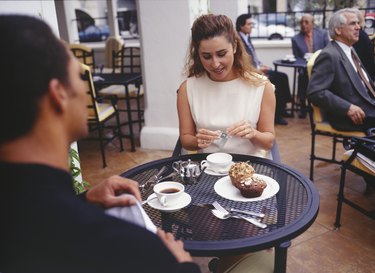
Splenda, the brand name for the sugar substitute sucralose, is found in packets to add to tea or coffee, and is also added to many diet soft drinks, chewing gums, juices and even health bars. As a sugar-free sweetener, Splenda is helpful for those wanting to cut back on added sugars or carbohydrates, but it can cause some side effects, including bloating and diarrhea.
Safety of Splenda
Video of the Day
Splenda is considered generally safe for consumption by the U.S. Food and Drug Administration. A non-nutritive sweetener -- meaning it does not provide any nutritional value -- it was also found to be safe in an independent review published in 2009 in "Regulatory Toxicology and Pharmacology." However, nurse practitioner Marcelle Pick still questions the safety of Splenda, given that many of the studies are short-term and some studies show potentially harmful side effects, including problems with kidney and liver health, when excessive amounts are consumed.
Video of the Day
Common Side Effects and Production
Splenda is made by adding chlorine to regular sugar, increasing the number of chlorine atoms. Because of this alteration, Splenda passes through the gut undigested, which is what makes it "calorie-free." According to Columbia University, sucralose, as well as other artificial sweeteners, can cause bloating, gas and diarrhea. When eaten in large quantities, Splenda may have a laxative effect. This includes Splenda that is added to foods during production, as well as Splenda that you add yourself.
Changes Gut Flora
Part of the reason for Splenda's laxative effect might be because it changes the bacteria content in your gut. Healthy gut flora leads to minimal gas production as a process of digestion. However, Splenda consumption may increase nitrogen gas and may increase the amount of water in your colon, which can cause diarrhea. An animal study published in 2008 in "Journal of Toxicology and Environmental Health" found that, over the course of a 12-week period, sucralose reduced healthy bacteria content and increased the amount of bacteria found in stools. Researchers concluded that high or regular sucralose consumption leads to lower healthy gut bacteria levels and may affect the absorption of certain medications.
Using Splenda
Splenda can be used in place of sugar in all foods, including baked goods, because it has been treated with maltodextrin to make it more stable at high temperatures. While sucralose is close to 600 times sweeter than sugar, Splenda, because it is mixed with maltodextrin, has the same sweetness intensity as regular sugar. While you can use Splenda in place of sugar in cooked foods and to sweeten your tea and coffee, substituting Splenda for sugar all the time may be difficult because it costs more than sugar.